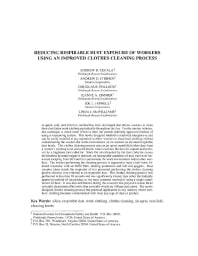Mining Publication: Reducing Respirable Dust Exposure of Workers Using an Improved Clothes Cleaning Process
Original creation date: April 2007
Authors: AB Cecala, AD O'Brien, DE Pollock, JA Zimmer, JL Howell, LJ McWilliams
NIOSHTIC2 Number: 20032621
Int J Miner Res Eng 2007 Apr-Jun; 12(2):73-94
A quick, safe, and effective method has been developed that allows workers to clean their dust laden work clothing periodically throughout the day. For the mining industry, this technique is much more effective than the current federally approved method of using a vacuuming system. This newly designed method is relatively inexpensive and can be easily installed at any operation to allow workers to clean their clothing without contaminating the worker, the work environment, or co-workers to elevated respirable dust levels. This clothes cleaning process uses an air spray manifold to blow dust from a worker's clothing in an enclosed booth, which confines the dust for capture and removal by a baghouse dust collector. Since the air exhausted by the dust collector causes the booth to be under negative pressure, no measurable quantities of dust were ever measured escaping from the booth to contaminate the work environment and/or other workers. The worker performing the cleaning process is required to wear a half-mask fit tested respirator with an N100 filter, hearing protection, and full seal goggles. Dust samples taken inside the respirator of test personnel performing the clothes cleaning process showed very minimal to no respirable dust. This clothes cleaning process was performed in less than 20 seconds and was significantly cleaner than either the federally approved method of vacuuming, or the most common method of using a single compressed air hose. It was also determined during this research that polyester-cotton blend coveralls clean more effectively than coveralls which are 100 percent cotton. The newly designed clothes cleaning process has potential application to any industry where workers' clothing becomes contaminated with most any type of dust or product.

NIOSHTIC2 Number: 20032621
Int J Miner Res Eng 2007 Apr-Jun; 12(2):73-94